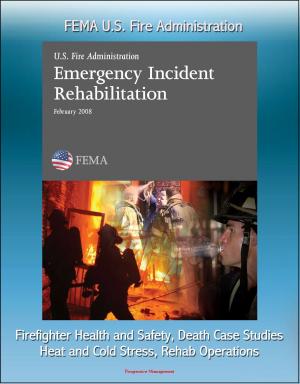2013 National Gang Report: Street, Prison, Outlaw Motorcycle, Drug Trafficking, Organized Crime, Weapons, Explosives, Eme, Mexican Mafia, Bloods, Crips, Latin Kings, OMG, BCF, Los Zetas, Pagans
Nonfiction, Social & Cultural Studies, True Crime| Author: | Progressive Management | ISBN: | 9781311255143 |
| Publisher: | Progressive Management | Publication: | January 26, 2015 |
| Imprint: | Smashwords Edition | Language: | English |
| Author: | Progressive Management |
| ISBN: | 9781311255143 |
| Publisher: | Progressive Management |
| Publication: | January 26, 2015 |
| Imprint: | Smashwords Edition |
| Language: | English |
The 2013 National Gang Report (NGR) represents an overview of current gang activities and trends in the United States. Intelligence herein depicts survey data retrieved collectively from the National Gang Survey (NGS) of the National Alliance of Gang Investigators Associations (NAGIA); the Gangs and US Border Survey conducted by US Customs and Border Protection (CBP); open source reports; and anecdotal examples of gang activity as captured by state, local, tribal and federal gang investigators across the nation.
Preface * Executive Summary * Key Findings * Scope and Methodology * Definitions. * Street Gangs * Prison Gangs * Outlaw Motorcycle Gangs * Gangs, Drug Trafficking Organizations, and Organized Crime Syndicates * Gang Migration * Gangs and Financial Crimes * Gangs and Technology * Gang Members' Employment in Government Institutions * Gangs, Weapons, and Explosives * Gangs in Educational Facilities * Female Roles in Gangs and Female Gangs * Gangs, Prostitution, and Human Trafficking * Gangs and the US Border * Gangs and Extremist Groups * Law Enforcement Actions and Resources * Outlook * Acknowledgments * Appendices * Endnotes
A comprehensive overview of gang activity in the United States, the 2013 NGR examines gangs from a national standpoint and explains how they function as sophisticated criminal networks that engage in all levels of crime in order to further their objectives to gain control of the territories they inhabit and generate revenue. As the 2013 NGR demonstrates, gangs expand their reach through migration into communities across the nation; collaboration with other illicit networks like drug trafficking organizations (DTOs) and rival gangs; active recruitment of membership; and through the absorption of smaller, less visible neighborhood-based gangs (NBGs), which continue to negatively impact US communities at a greater rate than national-level gangs. Intelligence herein also reviews how gangs perpetuate their criminal enterprises through their ability to adapt to changing social and economic environments; exploit new technology; target law enforcement; evade law enforcement detection; and enroll or employ within educational facilities, law enforcement agencies, government bodies, and through all branches of the US military.
KEY FINDINGS - Gangs continue to proliferate, evolve, and develop criminal tradecrafts. Based on state, local, and federal law enforcement reporting, the NGIC assesses that: The US gang composition is approximately 88 percent street gang members, 9.5 percent prison gang members, and 2.5 percent outlaw motorcycle gang (OMG) members. NBGs pose the most violent and significant threat in most communities while prison gangs are viewed as the least problematic in most jurisdictions. OMGs are reported as the greatest threat in approximately 11 percent of jurisdictions, despite comprising only 2.5 percent of the gang composition.
Gangs continue to commit violent crimes, including assaults, and robberies, and threats and intimidation more so than white collar-type crimes such as identity theft and credit card fraud. Drug trafficking was identified as the most common criminal activity of gangs.
Gangs rely on street-level drug distribution and trafficking as their primary source of revenue and supplement their income with crimes that pose less risk, such as prostitution, tax fraud, counterfeiting, and extortion. Street gangs utilize legitimate businesses, such as music establishments and cash-intensive companies to conceal and launder illicit proceeds.
Prison gangs launder criminal proceeds through tax fraud and extortion schemes, and Green Dot card/prepaid card technology. Family members, friends, and compromised correctional staff often facilitate gang activities and recruitment during a gang member's incarceration.
The 2013 National Gang Report (NGR) represents an overview of current gang activities and trends in the United States. Intelligence herein depicts survey data retrieved collectively from the National Gang Survey (NGS) of the National Alliance of Gang Investigators Associations (NAGIA); the Gangs and US Border Survey conducted by US Customs and Border Protection (CBP); open source reports; and anecdotal examples of gang activity as captured by state, local, tribal and federal gang investigators across the nation.
Preface * Executive Summary * Key Findings * Scope and Methodology * Definitions. * Street Gangs * Prison Gangs * Outlaw Motorcycle Gangs * Gangs, Drug Trafficking Organizations, and Organized Crime Syndicates * Gang Migration * Gangs and Financial Crimes * Gangs and Technology * Gang Members' Employment in Government Institutions * Gangs, Weapons, and Explosives * Gangs in Educational Facilities * Female Roles in Gangs and Female Gangs * Gangs, Prostitution, and Human Trafficking * Gangs and the US Border * Gangs and Extremist Groups * Law Enforcement Actions and Resources * Outlook * Acknowledgments * Appendices * Endnotes
A comprehensive overview of gang activity in the United States, the 2013 NGR examines gangs from a national standpoint and explains how they function as sophisticated criminal networks that engage in all levels of crime in order to further their objectives to gain control of the territories they inhabit and generate revenue. As the 2013 NGR demonstrates, gangs expand their reach through migration into communities across the nation; collaboration with other illicit networks like drug trafficking organizations (DTOs) and rival gangs; active recruitment of membership; and through the absorption of smaller, less visible neighborhood-based gangs (NBGs), which continue to negatively impact US communities at a greater rate than national-level gangs. Intelligence herein also reviews how gangs perpetuate their criminal enterprises through their ability to adapt to changing social and economic environments; exploit new technology; target law enforcement; evade law enforcement detection; and enroll or employ within educational facilities, law enforcement agencies, government bodies, and through all branches of the US military.
KEY FINDINGS - Gangs continue to proliferate, evolve, and develop criminal tradecrafts. Based on state, local, and federal law enforcement reporting, the NGIC assesses that: The US gang composition is approximately 88 percent street gang members, 9.5 percent prison gang members, and 2.5 percent outlaw motorcycle gang (OMG) members. NBGs pose the most violent and significant threat in most communities while prison gangs are viewed as the least problematic in most jurisdictions. OMGs are reported as the greatest threat in approximately 11 percent of jurisdictions, despite comprising only 2.5 percent of the gang composition.
Gangs continue to commit violent crimes, including assaults, and robberies, and threats and intimidation more so than white collar-type crimes such as identity theft and credit card fraud. Drug trafficking was identified as the most common criminal activity of gangs.
Gangs rely on street-level drug distribution and trafficking as their primary source of revenue and supplement their income with crimes that pose less risk, such as prostitution, tax fraud, counterfeiting, and extortion. Street gangs utilize legitimate businesses, such as music establishments and cash-intensive companies to conceal and launder illicit proceeds.
Prison gangs launder criminal proceeds through tax fraud and extortion schemes, and Green Dot card/prepaid card technology. Family members, friends, and compromised correctional staff often facilitate gang activities and recruitment during a gang member's incarceration.















